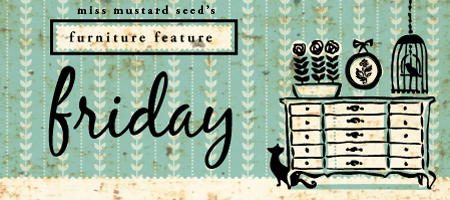I think this piece, however, will stay for good.
I bought it from a craigslist ad late last summer, with full intentions to sell at the October barn sale. But when I got it done--holy cow--I decided I had to bring it in!
Since I paint at least 80-100 pieces of furniture between my two barn sales, I have a pretty tried and true process for painting...and no, I don't use Annie Sloan Chalk Paint. I still have yet to purchase any! I know, I'm probably the only one who doesn't use it, but I'm a satin latex kind of girl.
Sadly, I don't have a photo of the china cabinet before I started, but it was very drab walnut stain, and was missing it's shelves. Here's the basics:
1) Give it a good cleaning to get old grime and dirt off. My favorite product is Arm and Hammer Super Washing Soda, which is in the cleaning supply or laundry aisle of the grocery store or WalMart. You won't believe how much dirt, old varnish and wax, and dirty build up will come off the surface. I've also used TSP to remove grime and at the same time "prep" the surface for painting.
2) Start sanding. Sanding preps the surface so paint will stick. I use an electric mouse sander at the start. Wipe all dust with a tack cloth, which you can pick up in the paint department for about $1.00. If you don't want to buy one, just be sure you get all sanding dust off. Wet wipes work good for this too.
3) To prime or not prime? It's rare for me to prime a piece of furniture. Mostly because I distress almost every piece and I don't like the white primer showing through the distressed areas. It's just a personal preference. Now, if you paint with Annie Sloan, priming isn't an issue...it's not needed, nor do you have to sand I'm told.
4) Begin painting...I always use latex satin and a foam brush. I paint with so many colors at one time that I don't want to be cleaning my paint brush all day long. So, I use a foam brush and then just wrap it in a plastic bag until my next coat. The more time you can wait in between coats, the better. At least half a day--over night is best. I always use at least two coats of paint, depending on what distressing technique I plan to use. But most jobs take two coats. If it's a table top surface or dresser top, I wet sand in between the coats of paint. Wet sanding gives a very sleek, smooth surface when you're done. If you take this route, be sure to use wet sand paper, not regular. It's black and much finer than the brown sand paper. Now is when you'd also paint any decorative trim, such as I did on the cabinet door and legs. After second coat is dry you're ready for your glaze and top coat.
5) This piece was glazed with a dark brown paint. I just pour glaze into a styro bowl and then drip some paint into it. I don't have exact measurements, but maybe about 2 parts glaze to 1 part paint. I dip a cotton rag into the glaze and dab/wipe it into the areas with crevices, grooves, trim, etc., then wipe off excess before it dries.
I use to always finish with a satin latex polyurathane, usually Varathane brand. But now I almost always use finishing wax in clear or dark, again depending on the look I'm going for. For this cabinet, I chose dark BriWax. Always read the directions on the can, each wax is different. I have found that I don't wait as long as the can says before buffing. If the wax dries too long, it's difficult to buff it out shiny. Some wax should not come in contact with water for any period of time...so those waxes are not good for dining table tops. For my clear wax, I use Johnson's Finishing Wax.
I usually put on two coats of wax on the surfaces that will get more wear...like table tops, dresser tops, etc. Sides and legs usually get one coat.
6) Now you're ready for finishing touches like hardware. If don't already know, Hobby Lobby has the best selection of knobs and drawer pulls. They are frequently 2 for 1.
Here's the finished piece.

Then I started to fill her up...


It's been moved three times already in my family room, and here's how it stands right now.
I'll let you know if I decide to sell this turquoise beauty. In the meantime, jot down my barn sale dates, June 15 & 16th. I'll have a boat load of other pieces for you to pick from! See you then.
Hop on over to:









2 comments:
Oh, I would be so tempted to keep that one, too! You did a great job! I have yet to try annie sloan paint, too.
Hi, Thank-U for sharing your painting techniques...I am trying to re-paint a couple pieces that I have, and have'nt gotton it quite right yet. Made my own Chalk Paint, cuz I was reading how everyone raved about it...not sure If I like it...kind of rough feeling...anyway, glad to find someone doing a beutiful job using regular satin paint! Love that :D
Smiles,
Christine
Post a Comment